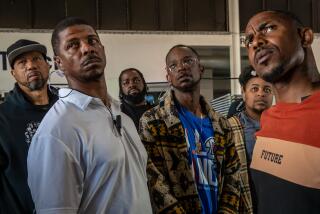Program Cultivates Young Entrepreneurs
- Share via
ENCINO — James Motter, 18 and a newly minted high school graduate, has friends who work delivering pizzas and taking tickets at the local movie theater.
Motter, a tall, lean teen who’s now a freshman at UCLA, works too--but he’s more like what they used to call a junior executive.
More than two years ago, at the ripe old age of 16, he was offered a chance to work at an Encino-based insurance and financial services company, handling office administration duties including application processing, doing research into computer-related upgrades and even handling money transfers for agency clients.
Now Motter, one of two teenage administrative assistants for the Levey Organization, says modestly, “I feel capable of running a small business by myself.
“I have an edge on anyone else,” without similar work experience, said Motter, a June 2000 graduate of Crespi Carmelite High School in Encino. “Someone looks at my resume and they see three, four, five years of experience. How can they look at that as anything but a lot of practical experience?”
Motter and his co-worker, 17-year-old Justin Steinhardt, are among the nearly two dozen teens to participate during the last three-plus decades in a unique youth mentoring program run by Robert B. Levey--former scoutmaster, backer of the Junior Achievement program, head mentor and head of the Levey Organization.
And they are emblematic of teenagers today who are opting for office jobs while most of their peers continue to sling burgers and run cash registers.
Although the vast majority of working teens still hold down retail-related jobs, youth labor experts say that--thanks in part to the increased computerization of the office--they are seeing more and more teens working behind a desk.
“We’re getting an increase in the number of office jobs that are available for young people, especially internships and temporary jobs,” said Melina Reimann, executive director of L.A. Youth at Work, a private nonprofit agency that runs the city’s youth employment and training program.
“Our traditional mind-set is that young people work at McDonald’s,” said Reimann, who said she has seen a more than 30% increase in the number of office jobs offered through her program in the past two years. “I think today, employers are acknowledging that most young people are familiar with computers and they’re recognizing the value young people can bring to an office setting.”
*
A June 2000 report from the U.S. Department of Labor showed that retailing remains the No. 1 job option for youths 15 and older. Of the 7.2 million teens who worked in 1999, nearly 52% were employed in retailing, a Labor spokesman said.
And Darlene Adkins, coordinator for the D.C.-based Child Labor Coalition, says that has held steady during the past several years.
“Most offices are in operation while school is in session,” said Adkins. “That’s probably why you don’t see more kids in offices. The retail industry is the No. 1 employer [of teens], and eating and drinking establishments are a big chunk of that.”
Reimann said local experience mirrors national trends, but she is seeing a marked increase in the number of employers opening their offices to teen workers.
“Over the past two years we’ve seen it rise sharply,” she said. “Fast food is fine, but we’re seeing more [employers] who are tapping into the resources that young people can bring to an office environment.”
For Levey, having young people in the office is nothing new.
He said he began his mentoring program back in 1962, about two years after starting his own business.
The youths report for duty after school. While on the job, they perform typical office duties but also learn “the principles of an entrepreneurial business, with an emphasis on positive family values.”
Leaning toward a sign he created to promote the concept of responsibility, Levey said, “Those values are taught in a subtle way.”
Levey sees himself as a mentor, someone who “guides a person in most of the things they do in life, like a trusted advisor.”
Motter said he sees Levey and Levey’s associate, John Bauer, who also works out of the Encino office, as friends.
Levey has firsthand knowledge of what it’s like to be a teen working in a grown-ups’ world.
“I worked with my dad when I was 15,” said Levey, referring to his days in the 1940s working for his father’s insurance company. “We did everything there was to do--bookkeeping, marketing proposals, filing.”
He guesses he made about $1 an hour, “and I got dinner every night.”
Today, his youthful staff earns substantially more--upward of $9.50 an hour, which is more than the minimum wage.
Levey was reluctant to reveal the salary information, but did so to make the point that “We don’t take these kids on because they’re a bargain.
“Our pay scale would be the same” for a non-teen worker, Levey said. “We know that they’re significantly ahead of their peers in remuneration.”
But other teenage office workers may not be as lucky, according to Adkins, whose coalition of 50 organizations monitors child labor issues.
“My concern for young people working in an office environment is: Are they being paid under the table for their work?” If so, she said, that could raise questions of pay inequity.
Other experts wondered whether computer-savvy youths who design software programs for their adult bosses have the business savvy to negotiate the best deal for their intellectual property.
Levey said in the nearly 40 years that his program has been in operation he has never encountered any significant problems, or complaints from parents, or concerns from teachers.
Two or three times, he said, he had to let teen workers go because they “did not live up to the standards.”
He said he sets his standards high, seeking only students that are “high achievers in school, in the top 20% of their class,” with consistently good grades.
Many of the students are recommended by school faculty, but in other cases the youths are children of friends of the Levey family.
Of the 20 students to participate in the program, all but one has been male.
Levey said he had no explanation for the gender breakdown of the program, other than “That’s the way it’s worked out.”
He said several of the students have come from Crespi, an all-boys high school. And he noted that the program has included a few ethnic minorities.
He said that if a qualified young woman applied for a job, he would have no qualms about hiring her. (Guidance counselors with bright young women students, start your engines.)
*
Steinhardt, a Northridge resident who attends Granada Hills High School, is a relative of Bauer’s. In addition to the regular administrative duties, Steinhardt handles accounting work and designs the company’s marketing materials.
Steinhardt, who plans to go into marketing, sees his job as a vast improvement over doing grunt work at, say, an ice cream parlor.
“An office job is better,” Steinhardt said, “because you learn something that applies to life instead of just scooping ice cream.”
Motter was “just sitting around the house” when a Crespi teacher called and asked if he was interested in working for Levey.
Sometimes, Motter said, his friends do give him the razz for having such a nontypical teen job.
But “When I pick up the lunch tab or the dinner tab, they’re not complaining too much,” he quipped.
“Every time I tell people I work in a financial services business, they say ‘What?’ ” added Motter, who plans to go into the business after graduating. “So it’s definitely very atypical. But it’s definitely helped me prepare for anything.”
*
Valley@Work runs each Tuesday. Karen Robinson-Jacobs can be reached at Karen.Robinson@latimes.com.
More to Read
Sign up for Essential California
The most important California stories and recommendations in your inbox every morning.
You may occasionally receive promotional content from the Los Angeles Times.













